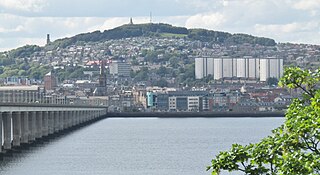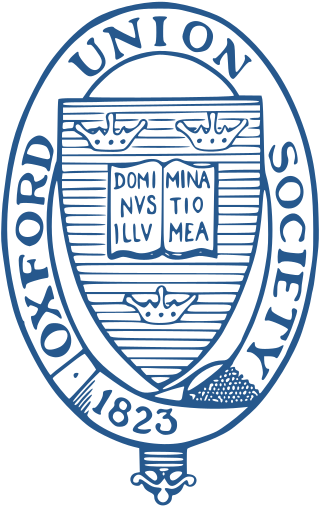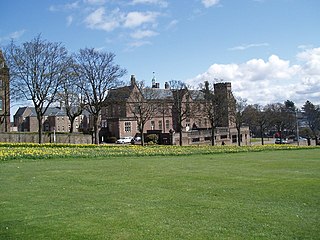
Dundee is the fourth-largest city in Scotland. The mid-year population estimate for 2016 was 148,210, giving Dundee a population density of 2,478/km2 or 6,420/sq mi, the second-highest in Scotland. It lies within the eastern central Lowlands on the north bank of the Firth of Tay, which feeds into the North Sea. Under the name of Dundee City, it forms one of the 32 council areas used for local government in Scotland. Within the boundaries of the historic county of Angus, the city developed into a burgh in the late 12th century and established itself as an important east coast trading port. Rapid expansion was brought on by the Industrial Revolution, particularly in the 19th century when Dundee was the centre of the global jute industry. This, along with its other major industries, gave Dundee its epithet as the city of "jute, jam and journalism".

The University of St Andrews is a public university in St Andrews, Scotland. It is the oldest of the four ancient universities of Scotland and, following the universities of Oxford and Cambridge, the third-oldest university in the English-speaking world. St Andrews was founded in 1413 when the Avignon Antipope Benedict XIII issued a papal bull to a small founding group of Augustinian clergy. Along with the universities of Glasgow, Aberdeen, and Edinburgh, St Andrews was part of the Scottish Enlightenment during the 18th century.

The Cambridge Union Society, also known as the Cambridge Union, is a debating and free speech society in Cambridge, England, and the largest society in the University of Cambridge. The society was founded in 1815 and is the second oldest continuously running debating society in the world, behind the University of St Andrews Union Debating Society. Additionally, the Cambridge Union has served as a model for the foundation of similar societies at several other prominent universities, including the Oxford Union and the Yale Political Union. The Union is a private society with membership open to all students of Cambridge University and Anglia Ruskin University. The Cambridge Union is a registered charity and is completely separate from the Cambridge University Students' Union.

The University of Dundee is a public research university based in Dundee, Scotland. It was founded as a university college in 1881 with a donation from the prominent Baxter family of textile manufacturers. The institution was, for most of its early existence, a constituent college of the University of St Andrews alongside United College and St Mary's College located in the town of St Andrews itself. Following significant expansion, the University of Dundee gained independent university status by royal charter in 1967 while retaining elements of its ancient heritage and governance structure.

Sir D'Arcy Wentworth Thompson CB FRS FRSE was a Scottish biologist, mathematician and classics scholar. He was a pioneer of mathematical and theoretical biology, travelled on expeditions to the Bering Strait and held the position of Professor of Natural History at University College, Dundee for 32 years, then at St Andrews for 31 years. He was elected a Fellow of the Royal Society, was knighted, and received the Darwin Medal and the Daniel Giraud Elliot Medal.
School debating in Scotland is a competitive activity taken up on an extracurricular basis by many schools across the country. The main format of schools debating in Scotland is British Parliamentary Style, and competitions in this format are mostly run by universities across Scotland, although more national university competitions, such as Oxford and Cambridge, hold regional rounds in Scotland as well. The BP format of debating consists of teams of two from individual schools. However, School debaters also have the opportunity to debate in the Worlds format of debating, if they are selected to represent their country as Team Scotland at the World Schools Debating Championships. Each year, twelve school pupils are chosen to trial and from this group a team of five is chosen.
John Mackintosh Howie was a Scottish mathematician and prominent semigroup theorist.
The history of the University of St Andrews began with its foundation in 1410 when a charter of incorporation was bestowed upon the Augustinian priory of St Andrews Cathedral. The University grew in size quite rapidly; St Salvator's College was established in 1450, St Leonard's College in 1511 and St Mary's College in 1537. Some of the college buildings in use today date from this period as does St Salvator's Chapel. At this time much of the teaching was of a religious nature and was conducted by clerics associated with the cathedral.
The University of St Andrews School of Medicine is the school of medicine at the University of St Andrews in St Andrews, Fife, Scotland and the oldest medical school in Scotland.
Academic dress at the University of St Andrews involves students wearing distinctive academic gowns whilst studying at the University of St Andrews. Undergraduate gowns in Scotland were once common at all the ancient universities of Scotland, with each having its own distinctive style. St Andrews undergraduates wear either a scarlet gown if they are part of the United College and studying in the Faculties of Arts, Medicine and Science, or a black gown if they are part of St Mary's College and studying in the Faculty of Divinity.

The rector of the University of Dundee is elected by the matriculated students of the University of Dundee. From 1967 to 2010, the rector was automatically a full member of the University Court. The rector also had the right to appoint an assessor, who was also a full member of the University Court. Following changes made to the university charter in August 2010, the rector must choose to take up full membership of the University Court or appoint an assessor who has full voting rights.

The Oxford Union Society, commonly referred to as the Oxford Union, is a debating society in the city of Oxford, England, whose membership is drawn primarily from the University of Oxford. Founded in 1823, it is one of Britain's oldest university unions and one of the world's most prestigious private students' societies. The Oxford Union exists independently from the university and is distinct from the Oxford University Student Union.

Undergraduate gowns are a notable feature of academic dress for students at the ancient universities in Scotland.

The Dundee Law School is the law school of the University of Dundee in Scotland. It provides undergraduate and postgraduate teaching in Scots and English law, permitting students to qualify into all three United Kingdom legal jurisdictions. The law school traces its roots to the University of St. Andrews, and has placed in the top 15 law schools in the UK on the University League Tables. The school is based in the Scrymgeour Building—named for Henry Scrymgeour, a 16th-century legal philosopher from Dundee—while the Law Library is based in the libraries building, both on the university's main campus. The Law School is part of the wider School of Social Sciences, Humanities and Law at Dundee.

Dundee Royal Infirmary, often shortened to DRI, was a major teaching hospital in Dundee, Scotland. Until the opening of Ninewells Hospital in 1974, Dundee Royal Infirmary was Dundee's main hospital. It was closed in 1998, after 200 years of operation.

Margaret Fairlie FRCOG FRCSE (1891–1963) was a Scottish academic and gynaecologist. Fairlie spent most of her career working at Dundee Royal Infirmary and teaching at the medical school at University College, Dundee. In 1940 she became the first woman to hold a professorial chair in Scotland.
The Abertay Historical Society (AHS) is a historical society based in Dundee, Scotland. It aims to promote interest in history, with a special focus on the history of Perthshire, Angus and Fife. The AHS runs a regular programme of public lectures on historical topics and also organises special events. The Society also publishes books, usually producing at least one publication per year.

The Literary & Debating Society is located at the University of Galway. The society was founded as the Literary and Scientific Society in 1846, and incorporated into the then Queen's College, Galway, in 1852. It has as its objective "the promotion of oratory among the students of the University, and the faculty of clear thinking and sound reasoning upon matters which may be deemed to be of vital importance".
The 1877–78 Scottish Districts season is a record of all the rugby union matches for Scotland's district teams.
The 1937–38 Scottish Districts season is a record of all the rugby union matches for Scotland's district teams.














